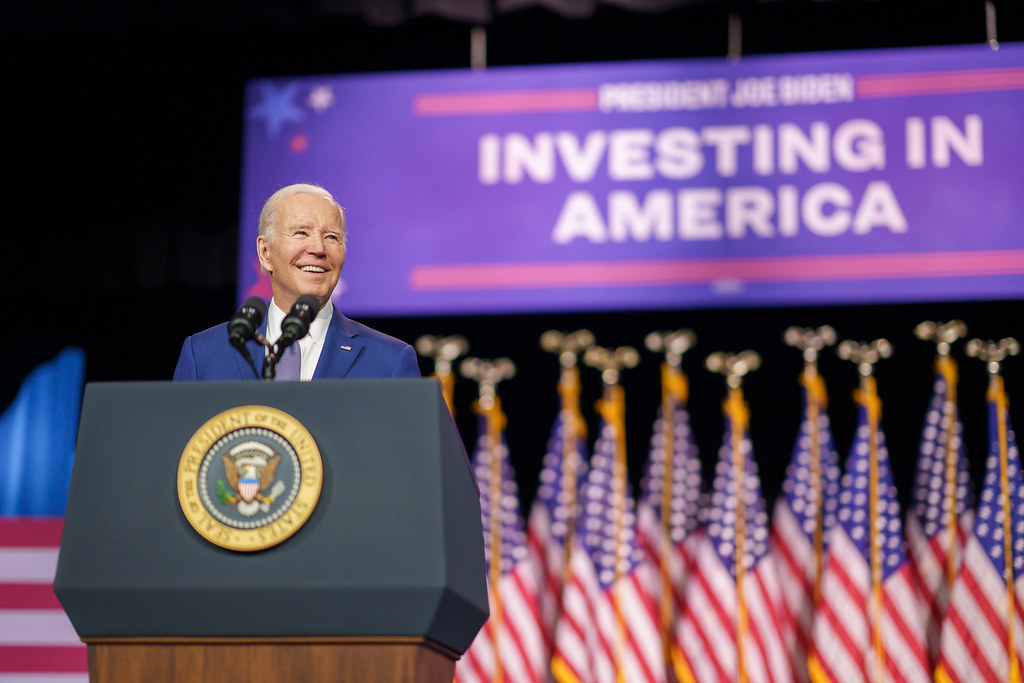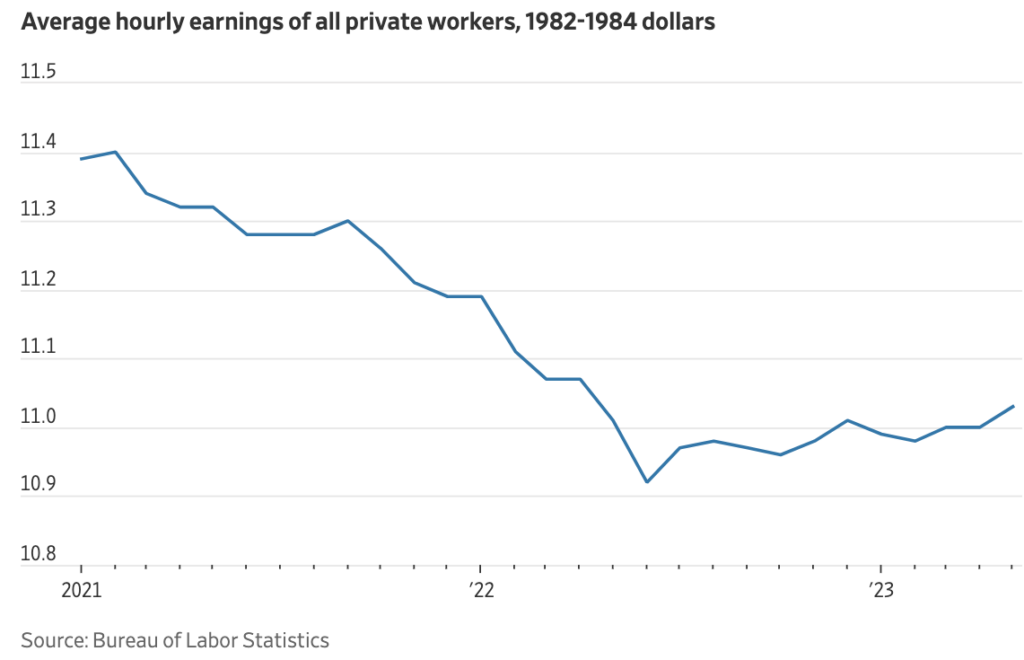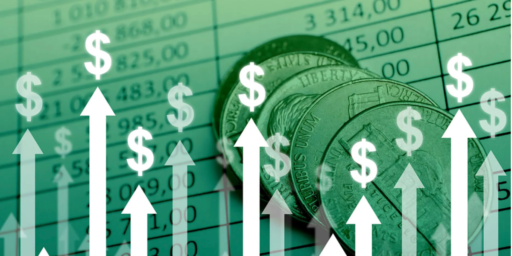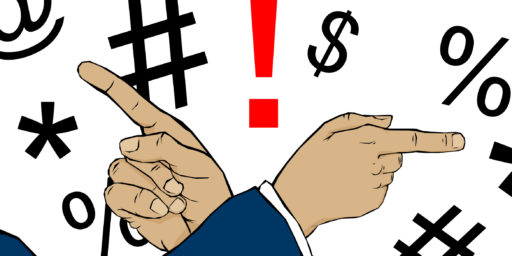Bidenomics?
The President is trying to change perceptions ahead of the election.

AP (“President touts ‘Bidenomics’ though new poll shows just 34% approve his handling of the economy“):
President Joe Biden made his pitch Wednesday to a skeptical public that the U.S. economy is thriving under what he now touts as “Bidenomics” — even as a new poll showed that could be a hard sell as the foundation for his 2024 reelection campaign.
In a major economic speech in Chicago, Biden said his administration’s efforts were sparking recovery after Republican policies had crushed America’s middle class. But the poll said only one in three U.S. adults approve of his economic leadership.
That 34% figure is even lower than his overall approval rating of 41%, according to the survey from The Associated Press-NORC Center for Public Affairs Research.
Biden’s approval figures have barely moved for the past year and a half, a source of concern for a president pursuing a second term on his ability to govern and focus on workers. He wants voters to connect local roads and bridge projects, factory construction and the rise of electric vehicles and renewable energy to the millions of dollars in initiatives he signed into law during the first two years of his administration.
“Bidenomics is about the future,” he declared in his Wednesday speech to cheering supporters. “Bidenomics is just another way of saying: Restore the American dream.”
At the same time, he sought to paint previous Republican tax cuts as deeply flawed, saying they helped the rich but failed the middle class for decades as the promised “trickle down” benefits never seemed to come to the less wealthy.
“The trickle down approach failed the middle class,” he said. “It failed America. It blew up the deficit. It increased inequity. And it weakened our infrastructure. It stripped the dignity, pride and hope out of communities, one after another.”
[…]
The new poll identifies a weakness within Biden’s own base. Many of the Democrats he needs to marshal in 2024 are comparatively unenthusiastic about his economic record. Seventy-two percent within his party say they approve of his handling of his job overall, but just 60% say they approve of his handling of the economy.
By comparison, during the depths of the pandemic as unemployment spiked, Republicans approved by overwhelming numbers of then-President Donald Trump’s economic leadership. Only about 1 in 10 Republicans now approve of Biden overall or on the economy, a testament to the polarization that defines modern U.S. politics.
[…]
Overall, 30% of U.S. adults say they think the national economy is good, up slightly from the 25% who said that last month, when the president and congressional Republicans were in the midst of negotiations over raising the nation’s debt limit and a historic government default was a risk. No more than about a third have called the economy good since 2021.
The administration is making a data-driven argument in addition to Biden’s speech. The Treasury Department released an analysis showing that spending on factory-related construction has doubled since 2021 after adjusting for inflation. White House economists issued a report that shows inflation is lower in the U.S. than the rest of industrialized nations in the Group of Seven.
White House aides believe that Biden’s speech on Wednesday can generate greater awareness of his policies and increase Democratic voters’ appreciation of the economy. While the president’s allies acknowledge that many Americans still hold dim views of the economy, they note that the actual economic data was far worse last November, when Democrats mounted a stronger-than-expected showing in the midterm elections.
Biden aides say they are encouraged by data showing Americans’ views can be changed by a consistent message reinforced on multiple fronts, which is what the president and his Cabinet are setting out to do by touring the U.S. over the next three weeks. Their hope is that repetition of Biden’s accomplishments, coupled with a contrast to GOP proposals to undo those initiatives, will stick with voters for 2024.
POLITICO (“Biden puts all his chips on the table with a push on ‘Bidenomics’“):
President Joe Biden is tying his political fate to the U.S. economy — recessionary risks be damned.
The White House this week is going all in on a campaign to claim credit for the nation’s post-pandemic resurgence, touting an economic vision that aides see as so central to Biden’s presidential legacy they’ve gone as far as giving it a name: “Bidenomics.”
It’s a fresh messaging push that marks the most aggressive attempt yet by Biden world to convince the public that the economy is, in fact, good. It’s also a major bet that the bottom won’t fall out, at least through November 2024.
“They’re going to wrap their arms fully around the economic strategy and economic results,” said Seth Harris, the former deputy director of Biden’s National Economic Council. “And I think their expectation is that there will not be a recession.”
The question of how strongly to tout the economy has vexed virtually every president running during a time of recovery. Boast too hard and voters may perceive you as out of touch. Stay too quiet and risk the perception of taking hold that times are bleak and getting bleaker.
Biden has pledged to avoid the missteps of his former boss, Barack Obama. He was reluctant in real time to play up good economic news after voters recoiled at his first attempt to do so though an infamous 2010 tour dubbed “Recovery Summer.” The current effort is an implicit recognition that Biden has more work to do.
Key to the sales pitch, which will include a speech Wednesday by the president formally outlining his economic case, is defining what exactly Bidenomics is. Ahead of the address, White House aides described the term as a broad collection of policies aimed at using government muscle to revive and reshape the economy to help the middle class. They pointed to a range of efforts, including bolstering manufacturing investments, expanding high speed internet access and cracking down on industries that charge so-called junk fees.
If the definition is a bit all-encompassing, the implication is clear. Biden’s political fortunes, his top aides believe, will hinge on how effectively they can hammer home the idea that voters are better off than just a few years ago — and have the Biden administration to thank for it.
“There’s going to be billions of dollars spent laying out what Joe Biden has done,” said one Democratic national political consultant familiar with the campaign strategy. “All these things are incredibly popular. But people don’t really know about them.”
[…]
Biden advisers privately acknowledge the hazards of centering an economy that’s likely closer to a peak than a valley, especially more than a year out from Election Day. Branding whatever happens over these next 17 months as the result of Bidenomics reflects an even bigger gamble, opening Biden up to a raft of attacks from his Republican opponents if the U.S. hits a downturn.
The administration’s attempt to label Biden’s economic legacy just more than halfway through his first term has struck even some Democrats as premature, and a potential unforced error.
“Bidenomics sounds like bad math,” said a Democratic strategist who was granted anonymity to speak frankly. “Bidenomics sounds like when my parents tell me something costs $2 and it’s $20.”
Shockingly, the WSJ Editorial Board (“Bidenomics in One Lesson“) is not impressed:
As it gears up for the 2024 re-election campaign, the White House is undertaking a political salvage operation over the economy. President Biden is now embracing what we have long called Bidenomics as a badge of honor, and he’s telling tales about how spthelendid everything is and why he deserves credit for it
The White House is going on this PR campaign because it can read the polls. Mr. Biden’s approval rating on the economy is 38.3% in the latest Real Clear Politics average. People don’t think the economy is all that great. So in Chicago on Wednesday Mr. Biden touted all the new construction going on from the spending that Democrats passed in the last Congress. And there’s no denying that when you spend literally hundreds of billions of dollars to subsidize certain industries, you can get new plants.
But then why are voters so unhappy? The answer can be found in one lesson by looking at the nearby chart. It tracks average real hourly earnings for all workers in the private economy across the Biden Presidency, and it tells an ugly story about the impact of the worst inflation in 40 years and the standard of living. This is the inflation that Mr. Biden did so much to ignite with all of his spending.
Here’s the chart (the version at the link is interactive):

It is, to say the least, odd. First, the y axis is in 10-cent increments, making the difference between the peak of $11.40 and the trough of $10.95 look enormous. Second, why the hell would you put a comparison of 2021, 2022, and 2023 in 1982-1984 dollars?
In 1982-84 dollars, which takes account of inflation, average hourly earnings were $11.39 when Mr. Biden took office but started to decline immediately and didn’t stop falling until inflation peaked in June 2022. They have bounced up a little but were still back only to $11.03 in May. That’s a 3.16% decline in real earnings for the average worker across the 29 months of the Biden Presidency.
It’s perfectly reasonable to adjust earnings for inflation. Indeed, while I’m a Federal employee and get annual cost of living adjustments, they have been decidedly lower than inflation, which has been the highest by far in my working life. But using 1982-84 dollars makes no sense here, in that it changes the baseline for no apparent reason.
I’ve tried to look up the numbers myself but can’t easily find them on the BLS site. But the fact that WSJ bizarrely changed them to 1982, 1983, and 1984 dollars is a pretty good indication that their argument is less interesting using the logical 2021, 2022, and 2023 dollars. It’s not like BLS doesn’t have a handy dandy inflation calculator to make that comparison easy.
These are official Labor Department statistics. Mr. Biden can’t deny them, so he had someone fudge the point by writing in his Chicago remarks that, “Look, pay for low-wage workers has grown at the fastest pace in over two decades.” We’d like to see how his economists cherry-picked the data to justify that one.
All of which reminds us of the old Marx Brothers joke: Who are you going to believe, me or your own eyes? Regarding Bidenomics, Americans should believe their own eyes.
These guys literally just fudged the numbers!
WaPo’s E.J. Dionne (“If ‘Bidenomics’ works, it will be a very big deal“) is, not surprisingly, more receptive.
President Biden might not seem like a revolutionary, but he is presiding over a fundamental change in the nation’s approach to economics. Not only is he proposing a major break from the “trickle-down” policies of Ronald Reagan, as Biden highlighted in a speech in Chicago on Wednesday. He is also departing from many orthodoxies that shaped the presidencies of Democrats Bill Clinton and Barack Obama.
Government is no longer shying away from pushing investment toward specific goals and industries. Spending on public works is back in fashion. New free-trade treaties are no longer at the heart of the nation’s international strategy. Challenging monopolies and providing support for unionization efforts are higher priorities.
You can trace the break in part to new circumstances and challenges, as national security adviser Jake Sullivan argued in an important speech of his own in April.
Heightened competition with China and the urgency of dealing with climate change are part of the story. So is the long rise of wealth and income inequality accompanied by the collapse of many of the country’s industrial communities. The breakdown of supply chains during the pandemic put an accent on resiliency and an emphasis on bringing home manufacturing, for semiconductors especially but for other products, too.
The shift also has to do with who Biden is, his long-standing alarm over the Democratic Party’s alienation from working- and middle-class voters and an unease with the Reagan-era economic consensus that hovered over Democratic administrations.
“When I worked for him as vice president,” Sullivan told me earlier this month, “he would frequently talk to me about his underlying discomfort with some of the prevailing economic assumptions, both with respect to trade and domestic investment.”
[…]
Bidenomics has also gone global. One indicator is the exceptional and ongoing debate Sullivan’s speech provoked in proposing a “new consensus” to replace “a set of ideas that championed tax cutting and deregulation, privatization over public action and trade liberalization as an end in itself.” The old formulas, Sullivan argued, not only failed to address new problems; they didn’t work on their own terms.
“In the name of oversimplified market efficiency,” he said, “entire supply chains of strategic goods, along with the industries and jobs that made them, moved overseas.” The idea that freer trade “would help America export goods, not jobs and capacity, was a promise made but not kept.” He stressed the need for “a modern American industrial strategy” and the benefits of “moving beyond traditional trade deals to innovative new international economic partnerships.”
Sullivan advised Hillary Clinton’s 2016 campaign against Donald Trump, and the election’s outcome provoked a long period of reflection on the anger he encountered throughout the country. “As I traveled across the United States on behalf of the campaign,” Sullivan wrote in Democracy Journal in 2018, “I was reminded again and again how the broken aspects of the American economy were not the inevitable product of disembodied forces like ‘globalization’; they were very much the product of policy choices shaped by decades of conditioning.”
The Biden-Sullivan project amounts to a program of deconditioning. Sullivan told me his speech “is really a description not just of my own journey on these issues” but also the journey of his generation responding to “the shortcomings of the previous approach.”
I’m deeply skeptical of industrial policy but agree with many parts of the Biden approach—which, ironically, echoes what his predecessor touted but largely failed to do. While I was very much part of the elite Western consensus on the virtues of globalization, the way that we did it created a race to the bottom that was good for us as consumers but bad for much of the working class, who had to compete against the unfair labor practices and shoddy standards of China and much of the global south. While Trump’s “America First” policies were mostly wrongheaded, it really makes sense to end our economic dependence on China. Further, while “Infrastructure Week” became a running joke under Trump, it absolutely makes sense to invest in green energy, transportation infrastructure, expanding broadband access, clean drinking water, and the like. The market simply won’t provide those organically, certainly not as fast as we need them.
As to the politics, it seems reasonable to take credit for popular policies that were only passed because had managed to cajole his own party caucus in Congress. The idea that, by labeling it “Bidenomics,” he’ll be blamed if the economy goes south is laughable. He’s going to be blamed for it, anyway! It has been thus for as long as I’ve been following presidential politics.
UPDATE: Commenter @Andy points out that it’s actually BLS, not the WSJ, who normalizes these figures into 1982-1984 dollars. Their rationale:
Since we first published the data in the mid-1970s, the headline ECI numbers always focused on nominal change in employer costs—that is, without any adjustment for inflation. Over time, these nominal changes have shown some wild swings, with annual changes in private sector wages above 9 percent in the early 1980s, and typically in the 1–3 percent range throughout the 2010s.
We also have had inflation-adjusted data available, although we didn’t previously highlight the numbers in the quarterly news release. The constant-dollar ECI, or real wage change, could move from negative to positive, based on changes in the CPI. For example, those 9+ percent annual changes in the nominal ECI in the early 1980s, when adjusted for inflation, resulted in a nearly 5-percent annual decline in real wages. More often, the constant-dollar ECI reported annual changes in the range of plus or minus 2 percent.
With recent increases in the CPI nearing 40-year highs, there’s more interest in whether wage growth is keeping up with inflation. Thus, we have expanded the availability of constant-dollar ECI data. The ECI uses the Consumer Price Index for all Urban Consumers (CPI-U), U.S. city average, to adjust for inflation. The process involves rebasing the CPI to match the ECI base period of December 2005. (The published CPI is currently based in the 36-month period from 1982 to 1984.)
One would think that, in the age of big data, it would be easy to update all of their figures to current dollars automatically. But this makes some sense.
My apologies for erroneously concluding that the WSJ editors were pulling a fast one.






The media goes out of its way to tell people the economy sucks and there is a recession around the corner, and then reporters act surprised when people say the economy sucks and there is a recession around the corner. Biden and the Dems have learned – or are learning – that if they want positive economic news THEY are going to have to push it. And polls that show Republicans don’t like Biden’s economic policies should be laughed at and dismissed. If Biden found a cure for cancer the GOP would indignantly ask why it took him so long.
The reason is pretty apparent to me: they are arguing in bad faith and manipulating the figures to that end.
There…FTFY
The most important thing about Bidenomics;
https://twitter.com/atrupar/status/1674101668856594462
@Mikey:
Indeed. The mutliplier from 1983 to 2023 is almost exactly 3. In 2023 dollars the vertical axis would run from 32.1 to 34.2. That makes it more likely that readers will notice just how small the changes would be on a, say, 0-35 scale. And also raises the question in people’s mind, if the average is around $33 today, why am I making so little?
@Charley in Cleveland:
Indeed. I saw a tv with FNC on the screen yesterday while Biden was speaking and it said something like “Public doubts economy amid recession fears” and I thought: the main reason there are “recession fears” is because the media keeps talking about them, not because the actually relevant fundamentals would indicate a recession.
Deflating back to a standardised reference year as 1982 (although a round year is more typical to avoid ‘cherry picking’ – e.g. 1980, or 1990 or 2000 – not that those years are magical but simply when one is doing deflators cherry picking a reference year is certainly a suspicion if one sees a peculiar range – unless say it is specifically analaysed years – X decades) would not be wrong, insofar as was doing a deflated comparison, but using a range (particularly that range) is just very strange … so not so much the usage of a deflator but the peculiar and non-standard fashion that it was done.
In any case it is certainly apparently a decent political bet to aim to move political conversation from culture war where ex abortion on losing ground to something addressing the meat and potato voter for appeal – even if the appealable margin is merely 5% this seems quite significant in a electoral geography context in USA.
Certainly there is beyond this a perfectly reasonable economic goal relative to assisting market adjustment in upskilled industrial labour
Since the economy is doing pretty good, yes it seems Biden’s approach is right, both policywise (except keeping Trump’s China tariffs) and in combating the perception of economic doom and gloom with a message of pragmatic positivity.
But why not message it “trickle-up economics” or some such? Biden is not popular, so labeling the approach “Bidenomics” is asking for reflexive hostility and ridicule.
Bidenomics…GDP growth for the first quarter was adjusted up, from 1.3% to 2.0%.
Thanks, Brandon!!!
@DK:
I wonder if he’s embracing it in the same way that the Obama administration embraced “Obamacare”. Turned a derisive insult into a plus and wrong-footed the Republicans.
@DK: Obamacare is quite popular if you refrain from calling it Obamacare. The GOPs succeeded in poisoning the name. I think Biden’s trying to forestall some of that. In reply to some message being decried as “simplistic” a couple days ago I, argued Ds need more and better simplistic messaging. I like “trickle up”. Tinkle down and all that went with it was more neo-liberal than Republican. A lot of Ds (Bill Clinton) also signed on to it, to their shame. But if Biden can paint its failure as Republican, more power to him. I also like Biden’s “build from the middle out and the bottom up”.
Brad DeLong wrote a rather long book, Slouching Towards Utopia arguing that afterWWII Keynesian econ seemed to work pretty good (although pols were more giving it lip service than practicing it). The the inflation of the 70s discredited Keynes and we went all neoliberal. Then the 2008 crash discredited neoliberalism. So now we’re flailing. Although there’s no good reason not to go back to Keynes. Which Biden may be doing.
SRTSS (Snappy Retort To Silly Statements) Otherwise known as “politics,” James.
Under Biden the economy is performing better than Trump, especially given that Trump put in a huge tax cut to stimulate the economy. That being said, debt is growing significantly faster than GDP. That is a major warning sign. I’m not a deficit hawk, but 5% annual increases in debt is not a sustainable trajectory when GDP grows at 2.5%. Unless we are in recession there is no way the deficit should be at $1.5 trillion (estimate for 2023). the current estimate for 2024 is $1.8 trillion.
@OzarkHillbilly: It wasn’t a criticism!
My laugh of the morning came from the angry customer in the #FJB shirt. Very confused when I asked why he was angry with Jeb Bush. He was still mumbling to himself and shaking his head as he crossed the parking lot.
The President – any President – is the Commander-in-Chief of the armed forces, not the economy. There is very little a President can do to absent a compliant legislature willing to pass whatever he or she wants. And even then, there is a limit to what the federal government can do.
Biden can do little to improve the economy, and fairly or unfairly, a dispositive number of voters will either give him credit or lay blame on him for their perceived state of the economy.
@Charley in Cleveland:
The “media” isn’t making things up out of thin air – economists and experts are saying these things. For many people, the economy does suck for them personally and has sucked. The don’t need to be told by “the media.” I’ve read many people on the left-side of the spectrum over the last many months complaining that the Fed is increasing interest rates too fast, which will cause an unnecessary recession.
What are you suggesting as an alternative? That the media should not report on predictions and analyses held by many in the economics profession including those aligned with Democrats?
No one really knows if we’ll have a recession or not. A recession is very much a potential outcome. Reporting on it is completely legitimate. The idea that the media shouldn’t talk about it and should instead focus on positive economic news is not how the media works, it’s not how the media has ever worked, nor should we want it to work that way. One can’t expect the media to do your political messaging for you.
@gVOR10:
Sure, trumpers think it’s a negative but who cares? It’s gradually sinking in to rational people that they may need Obamacare some day and so they are glad that it’s there. My nephew recently started a business and is looking at hiring his first employee. When I asked what he would do about healthcare he said he was looking into if he could cover an Employee’s Obamacare since there was nothing else available to a single employee business. Hell, his wife has serious health issues and he was only able to start his business because in the first place because of Obamacare. My daughter was able to leave a dead end job with a health insurance plan and get a free lance gig that lets her get resume building experience because she knows that when she ages out of our insurance she will be able to get Obamacare. And “Obamacare” is how that age group refers to it, at least the ones I know.
Trumps gonna trump, but if you feel like challenging them just point out that every Republican from Reagan to the Bushes to Trump promised we would eventually all have great health care plans provided we cut taxes for the rich. But Obama was the only one who delivered. But why bother. Trumpers gonna trump.
James,
It’s not the WSJ, the BLS uses those dates for constant dollar real wage comparisons.
For example, see this for an explanation and a BLS chart.
The BLS chart for real wages there shows the same decrease as the chart in the WSJ piece.
I don’t know why the BLS picked that date range, but it’s something they’ve standardized on for a while.
@Andy:
Absoulutely correct. But what Fox News et al is doing isn’t reporting, it’s brainwashing. And it works. Most trumpers believe that more jobs were added under Trump than Biden and Obama combined. I could go on to list a hundred things your average Fox viewer is completely wrong about because of the so-called reporting from those sources.
@MarkedMan:
Yes, Fox News is bad, and Trumpers are never going to give Biden credit for anything.
But only about 1% of the US population watches Fox News. Fox is not a massive force that influences public opinion outside the cohort of people who are already right-wing Fox News enjoyers. Fox is preaching to a small choir. If Fox ceased to exist, the Fox News enjoyers would find someone else to tell them what they want to hear.
In my view, this is a self-licking ice cream cone that is useless to complain about and isn’t a massive influence on the views of normie Americans.
@Andy: Thanks! I’ve used BLM data for years and somehow never noticed that.
@Andy: Yup. That’s been my position for a very long time. We give Presidents far too much credit/blame for the economy when their impact is relatively marginal. I think Biden deserves some of the blame for inflation since he pursued deliberately inflationary policies. Even there, though, the lingering effects of the pandemic in the supply chain was way more important. And the Fed seems hell bent on crashing the economy to stamp out inflation.
@MarkedMan:
@Andy:
The truth is, the only people who worry about unemployment, layoffs and a poor job market are the unemployed and some working for iffy business, everyone else worries about inflation. Come a recession and jobs and employment will rise in importance.
@Andy: we have been told by various outlets that a recession is, “just around the corner” for about two years now. At this point it is noise.
Also, the FED, when they have said the quiet part out loud has said the goal of the rising interest rates isn’t so much an inflation fight, but to stanch the wage growth that had been starting in early 2020.
@Andy:
True, and I’m not arguing, but I don’t know how market share translates into influence. 70-80% of people don’t really even pay attention to the news, regardless of source. My impression of cable news in general and Fox in particular is that there are a few hardcore trumpers who watch Hannity and Ingraham and the Wine Lady (and Carlson and Beck before that) religiously, and then they become the experts for their family and friends. And whatever they say is just reinforced by the chyrons that scroll by on the TVs in the waiting rooms, restaurants, bars, work cafeterias and breakrooms, etc.
I mean, what percentage of the population subscribes to the New York Times?
James: “It is, to say the least, odd. First, the y axis is in 10-cent increments, making the difference between the peak of $11.40 and the trough of $10.95 look enormous. Second, ”
This is the Wall Street Journal editorial page. It’s famous for doing this, for decades.
The Wall Street Journal is like a respectable hotel and restaurant which has a br*thel attached to if. One should be careful about which wing you are in.
@Andy:
“The President – any President – is the Commander-in-Chief of the armed forces, not the economy. There is very little a President can do to absent a compliant legislature willing to pass whatever he or she wants. And even then, there is a limit to what the federal government can do. ”
Something that the WSJ editorial page emphasizes every time that we have a Democratic president, and the economy gets better, after they have prophesied doom.
Remember, I was reading them throughout the 1990’s; I remember them declaring the the Clinton administration had trashed the economy (in the early 1990’s). In the late 1990’s, they loudly and repeatedly claimed that It Was All Due to Everything and Anything Else.
@Andy:
We passed a bunch of things in Biden’s first two years when he had a more agreeable legislature.
And Biden worked magic to get those passed, using his relationship with Manchin to keep him mostly on board.
Given that we are doing better than our peer nations in Europe, I think we’re doing something right.
@James Joyner:
Europe has had worse inflation. Did Biden’s policies cause that?
(I think we did better than Europe mostly by being a bit easier to ship to from China, and some efforts to keep transportation flowing — rail strike averted, etc)
@Andy:
Would that it were so, but Fox News manages to influence overall media coverage, thus extending its reach beyond its own viewership. For example, some of what Chris Licht attempted to do at CNN was to compete with Fox News.
@James Joyner: A president’s impact on the economy can be marginal, but it can also be outsized. It depends on what congress and the president do.
Tax policy and bailout policy can actually have a huge economic impact.
David Brooks is arguing in the NY Times today that Biden’s policies have had a positive impact on the economy:
Implied here is that “Bidenomics” might be prompting old school Reaganites like Brooks to rethink their views on economic interventionism. The view that goverment does not have much economic impact, and thus should take a hands-off approach lest a president upset market forces, is itself a view with a conservative bias. (Noting that many traditional Goldwater-style conservatives are politically homeless right now.)
Apparently Biden’s lowering of Prices is mainly in the Fuel category; by draining the Strategic Petroleum Reserve.
Prices in other areas are a still too high